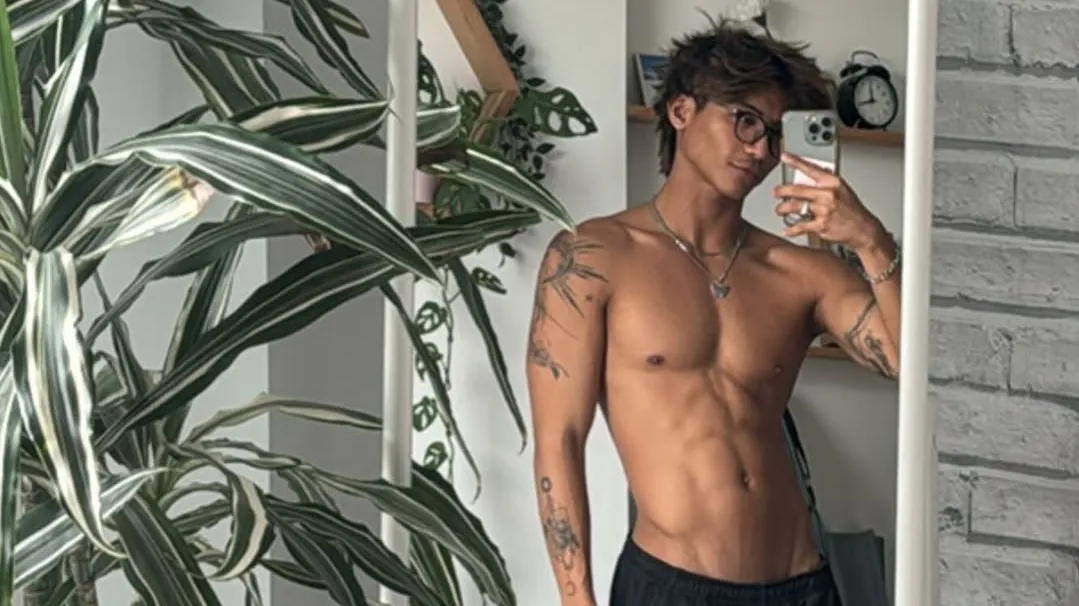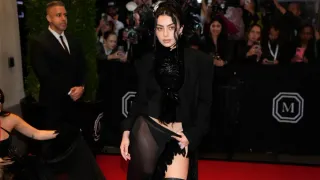April 2, 2015
She's A Very Kinky Girl; Going Beyond 'Fifty Shades'
Winnie McCroy READ TIME: 14 MIN.
When "Fifty Shades of Grey" debuted in the theaters last month, many people's eyes were opened to the wonderful world of kink. But in the LGBT community, kink has been around for decades. And although famed kink playgrounds like The Lure, The Hellfire Club and The Vault are no longer in existence, their spirit lives on in gay men's bars like The Eagle, at private play parties, and at events like the annual International Mr. Leather in Chicago and Black Party in New York. These days, women and transpeople are also creating their own safe space within the BDSM community.
"Community is a vague term; sometimes it just happens where you least expect it to happen," says educator Felice Shays, who spent seven years slinging silicone at sex-toy emporium Babeland. "Don't assume that it's going to look like what you think it looks like. There may be only one person you find something in common with."
Kink means different things to different people. Some are interested in the dominant and submissive power dynamics, whether or not that includes sex. Some people like bondage, and others are into S&M.
Shays suggests people start out by reading "The Topping Book" and "The Bottoming Book" by Dossie Easton or Tristan Taormino's "The Ultimate Guide to Kink." Watch porn, all kinds of it, and go online to see what turns you on. Try things at home with your partner, or go to sex clubs or play parties. Once you find one party, it will lead you to more.
"Look at what your own desire is, figure out what turns you on, what you masturbate to, what you would never do in real life -- and if you would do it, then do it," said Shays. "There are lots of different ways to find pleasure; there's not just one prescription for what works. Finding out what turns you on is a lifelong thing."
Where the Girls Are
In cities throughout the United States, kink and play parties abound. In New York City, the Lesbian Sex Mafia regularly meets at the LGBT Community Center, although for the past eight months they have been somewhat quiet.
SPAM is a regular New York City queer play party, as is the less frequent party Myth, which is mixed gay and straight. And Shays produced the NYC party Submit for six years, which is now held in Brooklyn and packed with about 100 people each month.
"They have a cool ice breaker in the beginning, to help people meet," said Shays. "It's totally intimidating to go to places where you don't know people, and I've been on the scene for 15 years. If you get brave and go to an event, sometimes it's good to drag along a friend or lover. Half the people there don't know what they're doing either."
Chicago has its own Leather History Archives, and Connecticut hosts Queer Invasion parties. There is a queer kink camp in Maryland, and the Radical Faerie IDA in Tennessee is sex-positive but doesn't have consent rules or hold introductions.
Boston holds the invitation-only private party Mob, at which no cisgender men are admitted; and San Francisco's The Exiles hosts regular events for women, among them the monthly Munch party. For those heavily into the scene, the International Ms. Leather competition is held in the City by the Bay in April. Shays said that she will teach several classes there this year, and looks forward to the Ms. Bootblack competition.
"This is a whole lot of fun, with dungeon time, lots of different spaces and equipment, and a lot of people playing," said Shays.
Rules for Play
When women and transpeople talk about the play parties they enjoy, the conversation returns time and again to the idea of creating truly welcoming spaces. Most say that this is best achieved when facilitators thoroughly vet attendees, institute strict "consent" policies and rules for play, and make guests feel welcome both by introducing players to one another and using express language that lets them know this party has been created just for them.
Lifestyle blogger Bevin Branlandingham of The Queer Fat Femme Blog Guide to Life first experimented with kink by attending a Lesbian Sex Mafia workshop with a date. Urban Tantra author and sex educator Barbara Carrellas wowed her with a presentation on fire play.
"It was so beautiful watching her set fire to Felice Shays," said Branlandingham. "There was so much skill involved, not in a sexy way but in a performative way. I love those aesthetic aspects of BDSM, like rope work. For me as a femme, a big part of my identity is the way I look and present, so sex in the way that I want to present is fun to me."
Branlandingham said that after reading "The Topping Book", she got a strong handle on issues of consent, adding that it was good to have literature in the community that promoted a strong core value of consent.
"Without 'no' there can be no 'yes,'" she said. "You have to be taught how to say no, or you are not going to be able to get to the enthusiastic 'yes.'"
"You need to have consent-based rules that are enforced by the party host," she said. "Some have a screening process for getting invited. At first I was turned off by it, but then I found I felt really safe in an environment where everyone had to agree to the same rules. I didn't worry that some guy would come up and start being sleazy with me."
Branlandingham also likes cruising wristbands, a new take on the old "hanky code," that indicates specific things people are interested in and whether they like to top or bottom.
"People should get familiar with the old flagging and hanky codes," she advised. "A meet-and-greet component is also crucial; without it, I'm like a wallflower. When I'm single, even if I'm not getting laid in real life, I will sometimes just go to a play party to feel like a sexual person, even if I'm not having sex. But I really need to know someone to want to have sex with them."
Finding deeper connections through sex is also a passion for Barbara Carrellas. In 2007, she was one of the first people to combine tantric sex and kink in her book "Urban Tantra," the first guide to tantric sex that wasn't from a "white, middle-aged, middle-class, New Age workshop-lover from Marin County, California," she riffs.
She first started studying tantric sex during the mid-'80s AIDS crisis, searching for a way for her gay friends to have safe sex that also had an emotionally nurturing, spiritual bent. Back then, she worked with Joseph Kramer, founder of the Body Electric School, and Annie Sprinkle, Queen of the Hellfire Club, New York's most notorious sex and BDSM club.
Carrellas saw parallels between what the BDSM community was doing with needles and elastic thread and what she was doing with energy and eye-gazing.
"It occurred to me in a flash that BDSM and tantra were the same thing, just done with different toys," said Carrellas. "Both push conscious sexuality to the max, both are edgy in their own right, and both are about knowing how to be in the present moment."
At that time, Carrellas confides, she was scared of BDSM and observed it from a safe distance. Her tantric experiences were "so heterosexual, it hurt," with one workshop facilitator telling her she couldn't have tantric sex with another woman, even suggesting that she find a man. But she wanted to write a book about tantra that included the queer and kink communities and so found a way to break down BDSM into an active/receptive binary, just like butch/femme, top/bottom, or master/slave.
"It's all for the purpose of amping up the energy," said Carrellas. "When you're in the magic of the moment, these roles drop away. As long as you know you're creating this binary for the sake of amping up the energy, then you can call it anything you want."
Carrellas teaches tantric workshops in power exchange that focus on this energy exchange rather than the roles, words or toys people assign. She finds that it helps people play with power more conscientiously.
Since "Fifty Shades of Grey" dropped, Carrellas has gotten a lot of questions about consent. She recently held a sold-out workshop at the New York Open Center, followed by a three-day intensive Urban Tantra Experience workshop in Western Massachusetts. After that, she heads to Copenhagen for a professional training program for people who work with sex in their occupation, from professional dominatrix to sex workers to doctors to writers. Her teaching will take her to Australia and London this year.
"I'm not a person of color or transperson, but my partner is trans, and making the world safe for queer transpeople and kinky people is one of my missions in life," said Carrellas. "And from my perspective, queer events have made a lot of progress. That was my intention with 'Urban Tantra': not to separate communities, but to get everybody in the same room to understand that we have shared interests, goals and desires. Our sexual preference or body or gender identity does not define our sexuality."
Trans and POC in Play Parties
If the BDSM and kink communities are more women- and trans-inclusive, it didn't happen by accident. Party producers and educators put in long hours to make these events truly welcoming.
"Finally there are safe spaces for women and transpeople," said Carrellas. "And much of it is largely due to the work of Tristan Taormino and her partner, Colten. When they were co-producers of Dark Odyssey from 2003 to 2010, they went out of their way to include queer people, LGBTs, genderqueer, people of color. They made it a mission to create a safe space, calling us to bring in conscious sex practices and get us all together to discuss tantra, BDSM and master/slave dynamics."
Baltimore play party producer Ignacio Rivera agrees, noting that parties like Queer Invasion and SPAM presented a mixed crowd and were open to queer, trans and gender-nonconforming people.
Sexual and gender diversity were just as important to Rivera, and so was racial diversity. So they set about about creating the play parties Desire and Phuk It in Brooklyn and the touring party Four Play, which has happened in Colorado, Berlin, London and Africa, as the peripatetic Rivera travels around the world.
"Those parties were definitely focused on queer women and nonbinary people, but they also had a huge concentration on race," said Rivera. "When I first started doing these parties, I spent three years inviting people of color only, and doing a lot of education, networking and connecting with queer and transgender people of color who had never accessed play parties or spaces, or wanted to but were afraid because they saw it as a solely white space. Then I opened it up and did multiracial parties."
As a transperson, Rivera was sick of parties that were only partially inclusive toward transpeople -- for example, not welcoming transwomen who hadn't had bottom surgery to expose their bodies. Some places would say everyone was accepted but never really welcomed women, genderqueer or binary people.
"The first time I ever went to a play party 15 years ago, I was terrified," said Rivera. "I was one of two or three people of color in a space with 100 other people. A white woman came up and asked to tie me up and flog me. In those spaces, flogging was normal, but the dynamics for a person of color... for her to ask me that without thinking of the implications of what that would feel like for me.... People in kink spaces think they are open, liberated people, but that sometimes negates the fact that we exclude or are not as liberated as we think we are. Kink exists in a beautiful bubble, but some of us have to keep a foot in the real world."
So Rivera set about using a language based on how people should be treated and respected, and created a scene that really honors diversity.
"When it comes to trans or nonbinary folks, these are spaces where you're at your most vulnerable and literally naked," said Rivera. "A lot of our communities do not desire, cannot afford to or do not have access to body-altering surgeries, so that is a huge source of discomfort for some people."
To instill a sense of comfort, safety and nonfetishized sexuality, Rivera works to create rules; to make sure the guest list is diverse in terms of gender, race, sexual orientation, body size, age and ability; and to do intense screenings of guests.
"My parties aren't huge and are not about making money, but rather about creating space and forming community," said Rivera. "I keep it to between 15 and 40 people. In order to do the parties I wanted, I have to make it smaller and more manageable."
If You Build It, They Will Come
Women and transpeople from across the gender spectrum have been involved in the BDSM community for years. Shays notes that women's place in S&M is strong and has deep roots in history. She has enjoyed watching it evolve and seeing more people understand their desires and sexuality, and work to develop networks and community.
Rivera agreed, saying, "In the 15 years that I've done play parties, I can now see that there are tons of queer and trans people of color creating their own smaller spaces within this community. I'm honored and privileged to have mentored a lot of them. It might not be happening in larger scales, but people are creating spaces where they can be sexually free."
Despite what's going on in the movies this month with "Fifty Shades of Grey," kink is still a marginalized community. But, thankfully, committed party producers are putting in the time it takes to make this scene truly diverse and welcoming to all.
"We all just want to get along and have fun, but we're scared of what we don't understand," said Carrellas. "But we have proved that there can be safe places. Occasionally, they are long and hard in the coming, and there are unfortunate situations where someone unfamiliar with queers says something hurtful, but more and more spaces are becoming queer friendly. It's a passion of mine, not just because I'm part of the community but because we are queering the straight world in quite a lovely way!"
Winnie McCroy is the Women on the EDGE Editor, HIV/Health Editor, and Assistant Entertainment Editor for EDGE Media Network, handling all women's news, HIV health stories and theater reviews throughout the U.S. She has contributed to other publications, including The Village Voice, Gay City News, Chelsea Now and The Advocate, and lives in Brooklyn, New York.





